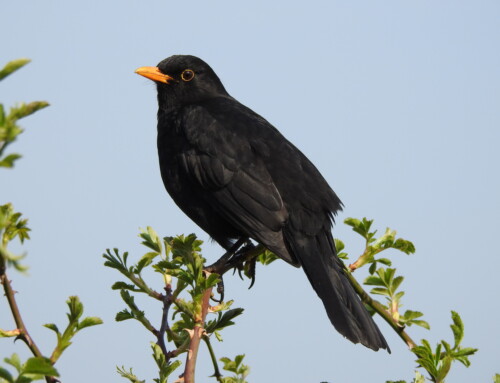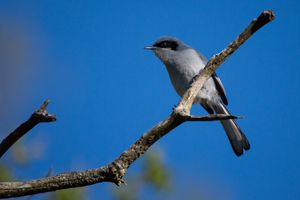 LINKED PAPER
LINKED PAPER
The impacts of parasitic flies (Philornis spp.) on nestlings of three passerines in a southern temperate forest of Argentina. Gonzalez, E.E., Jauregui, A. & Segura, L.N. 2021 Ardeola. doi: 10.13157/arla.69.1.2022.ra1 VIEW
Birds must coexist with a wide variety of ectoparasites including lice, mites, fleas, cimicid bed bugs and flies. Among them there is a group of 50 fly species of the genus Philornis from which most of the larvae parasitize nestlings. Once the larvae infest the nestling, they live subcutaneously and feed on serous fluids, tissue debris and blood. The larvae develop in their host for 4-8 days, reaching a length of 8-9mm, after which they drop from the host to the base of the nest, where they pupate. This event can cause detrimental effects on their hosts including increased nestling mortality, slower nestling growth rates, and increased post-fledging juvenile mortality. The degree of the detrimental effect will depend on multiple factors, among the most relevant are the species of bird, the size of the chicks, temperature and rainfall, nesting date, the number of larvae that infect each chick and the age of the chicks at the time of infection (Dudaniec & Kleindorfer 2006; McNew & Clayton 2018).
We decided to study the effect of this ectoparasite on three passerine species that nest in a southern temperate forest in northeastern Buenos Aires province, Argentina. This location has the peculiarity of being in the southern limit of the fly’s distribution (Cuervo et al. 2020), which given the greater seasonality of this region may influence flies populations differently compared to patterns observed at lower latitudes. Specifically, at higher latitudes appropriate climatic conditions for flies could be restricted to a shorter time span, which could result in a greater impact of parasitism during this limited period.
The bird species selected for this study were the Masked Gnatcatcher (Polioptila dumicola), the Vermilion Flycatcher (Pyrocephalus rubinus) and the Blue-and Yellow Tanager (Pipraeidea bonariensis). We based on a series of features that make them suitable for a comparative study, namely: they all have previously been reported as hosts of Philornis larvae, they are fairly common in the study area, and they differ in life history traits, nesting habits and body size which could impact the extent of parasitism. From this study we expected that there would be a negative relationship between parasite infestation and both nestling growth and survival. Since nestlings of these three host species differ greatly in body size, we predicted that nestling survival from parasitized nests, and parasite load per nestling, would be greater the larger the host species, and that the number of growth parameters differing significantly between parasitized and unparasitized nestlings would be greater the smaller the host species.
We monitored a total of 564 nests from October to February, over three breeding seasons. But for this study we only considered nests in which nestlings survived to at least the mean age at which we detected flies, resulting in a total of 244 nests. Some 72 nests were for the Masked Gnatcatcher, 143 for Vermilion Flycatcher and 29 for Blue-and-yellow Tanager. The results showed a prevalence of parasitism of 16.7% for the Masked Gnatcatcher (12/72 nests), 30.1% for the Vermilion Flycatcher (43/143 nests) and 37.9% for the Blue-and-yellow Tanager (11/29 nests) (Fig. 1).
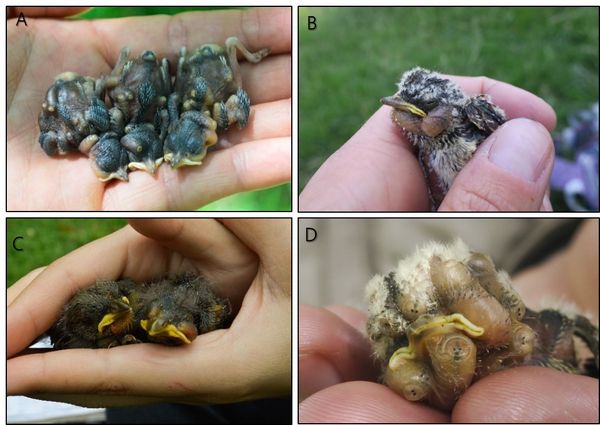
Figure 1 Nestlings parasitized by Philornis fly larvae: (A) Masked Gnatcatcher, (B) Vermilion Flycatcher, (C) Blue-and-yellow Tanager, (D) Close up of parasitic larvae.
Prevalence of parasitism (percentage of total nests parasitized) increased towards the end of the season for the three species (Fig. 2). This has been widely found in tropical and subtropical regions as well in other southern temperate regions (Segura & Reboreda 2011). The greater seasonality in our study site (lower temperatures at the beginning of the breeding season and higher temperatures and precipitation towards the end) may at first delay of emergence of adult flies and later enhance parasitism intensity.
Although parasite load per nestling (number of fly larvae per nestling) did not vary among species, when considering only parasitized nests that produced nestlings, the parasite load per nestling differed among species. It was significantly different between the Masked Gnatcatcher (1.2) and the Vermilion Flycatcher (5.6) and between the Masked Gnatcatcher and the Blue-and-yellow Tanager (6.8). This is because despite the fact that the nestlings of the three species can host a similar number of larvae, tolerance is considerably lower in the smaller species. This can be attributed to the fact that larger nestlings have greater tolerance of parasite damage.
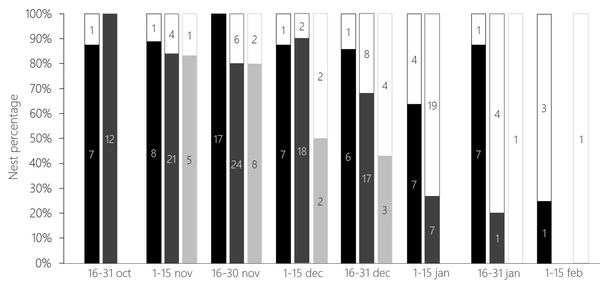
Figure 2 Percentage of non-infested nests (filled portion of each bar) and infested nests by Philornis larvae (empty portion of each bar), as a function of nesting date for the three host species (black bars = Masked Gnatcatcher, dark grey bars = Vermilion Flycatcher, light grey bars = Blue-and-yellow Tanager). Numbers of nests in each category are given within each bar portion.
Of the 55 parasitized nests (excluding depredated nests), all nestlings fledged from 12 nests (21.8%), all died in 38 (69.1%) and there was partial fledging (some nestlings survived, and some died) in five nests (9.1%). Nestling survival was lower in parasitized than in non-parasitized nests for all species (Fig. 3). As reported by others (Kleindorfer & Dudaniec, 2016) we found that all nestlings died in ~70% of parasitized nests and when compared to non-parasitized nests, nestling survival decreased from ~90% to ~30%. Contrary to what we expected, we did not find differences among species in nestling survival when considering parasitized nests, nor in the number of parasites per nestling. Nests that failed due to parasitism had higher parasite loads compared to parasitized nests that produced fledglings (Masked Gnatcatcher: 16.9 vs. 1.2; Vermilion Flycatcher: 18.7 vs. 5.6; Blue-and-yellow Tanager: 22.5 vs. 6.8).
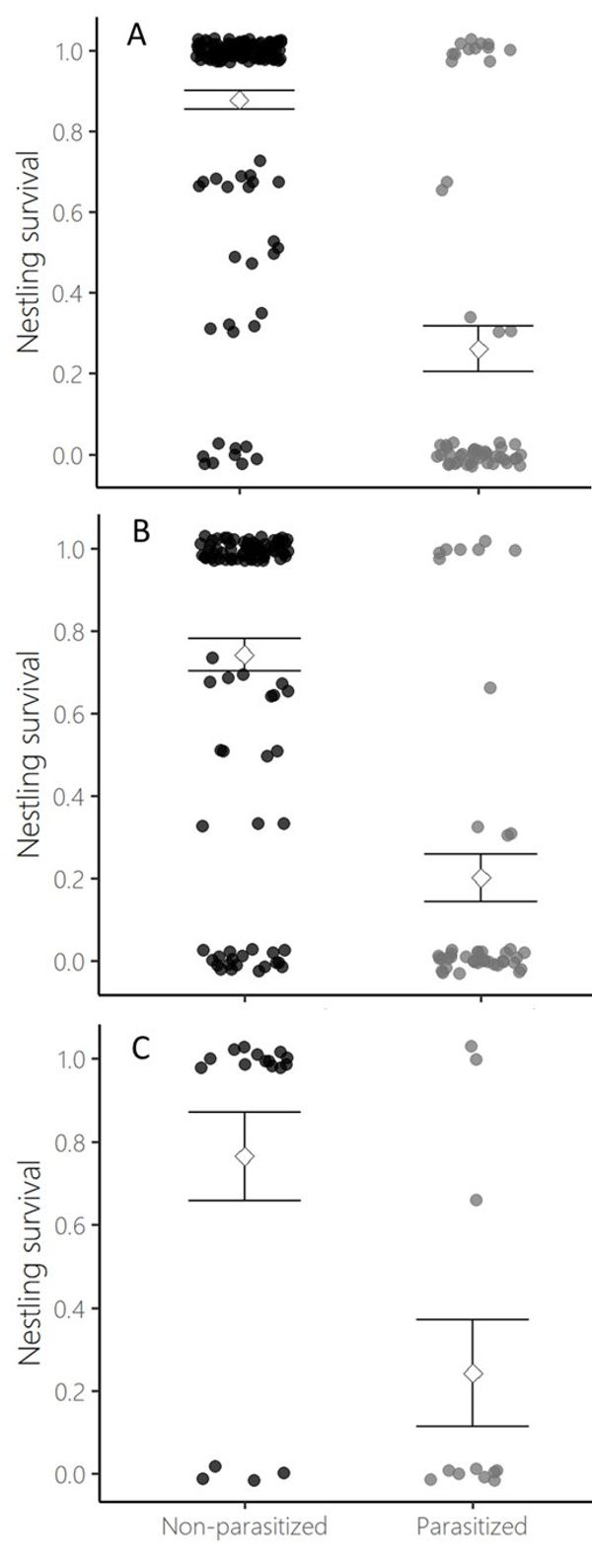
Figure 3 Nestling survival for parasitized and non-parasitized nests of (A) Masked Gnatcatcher, (B) Vermilion Flycatcher, and (C) Blue-and-yellow Tanager. Circles represent data distribution, diamonds the mean value for each data group, and the whiskers the standard error.
By taking a more comprehensive approach to all growth parameters, we found that not only were growth rates of parasitized nestlings lower when compared to non-parasitized nestlings (as others have reported), but also that significant differences existed in other growth parameters (Fig. 4). As predicted, the species with least growth parameters affected by Philornis parasitism was the largest species, the Blue-and-yellow Tanager.
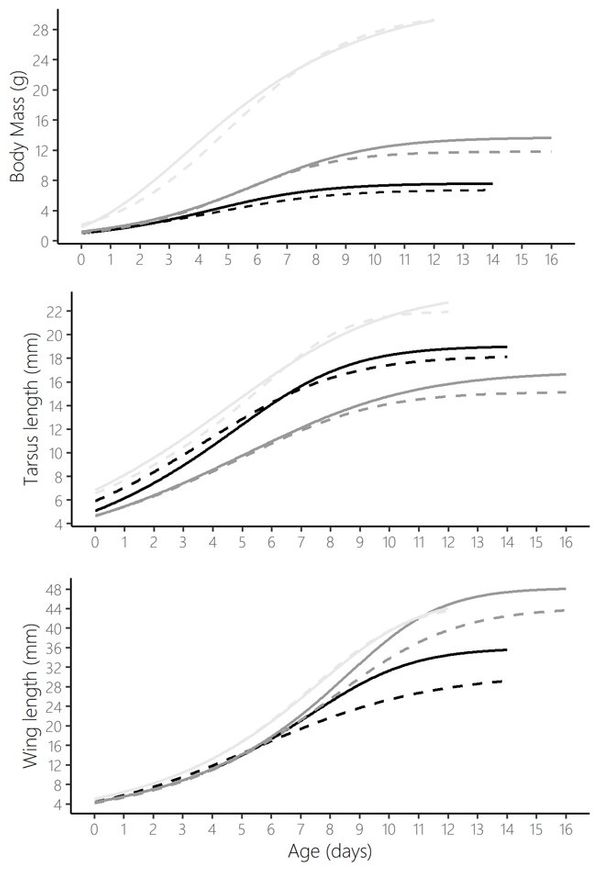
Figure 4 Growth curves for body mass, and tarsus and wing lengths for Masked Gnatcatcher (black), Vermilion Flycatcher (dark grey), and Blue-and-yellow Tanager (light grey) nestlings. Continuous lines indicate non-parasitized nestlings and dashed lines parasitized nestlings.
The large data set in this study across three years supports the conclusions we have presented, namely that Philornis parasitism within species’ native ranges may exert strong negative influences on host fitness causing ~80% nestling mortality and reduced nestling growth. These results can be useful if geographic shifts in parasite distribution patterns occur in future because of climate change, which could exacerbate the negative effects of parasitism and open new habitats for additional colonisation and range expansion by Philornis flies.
Image credit
Top right: Masked Gnatcatcher Polioptila dumicola © Exequiel Gonzalez.
If you want to write about your research in #theBOUblog, then please see here.




